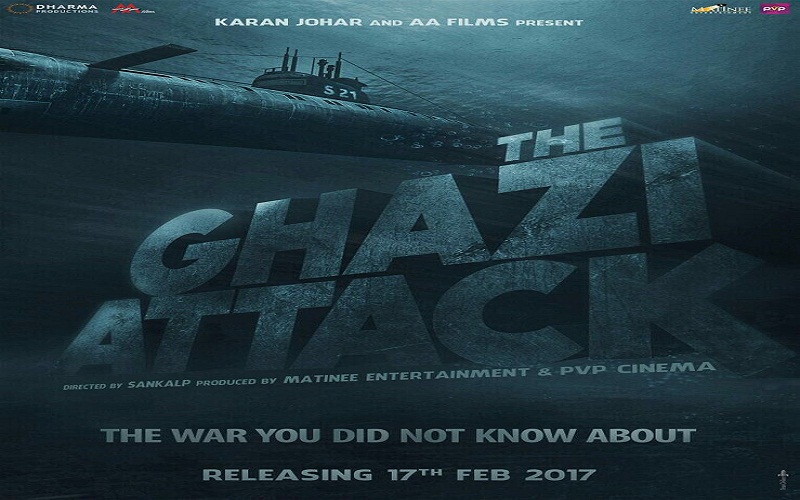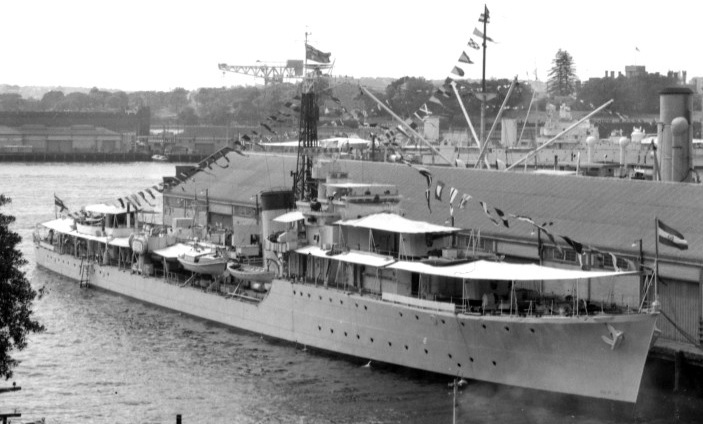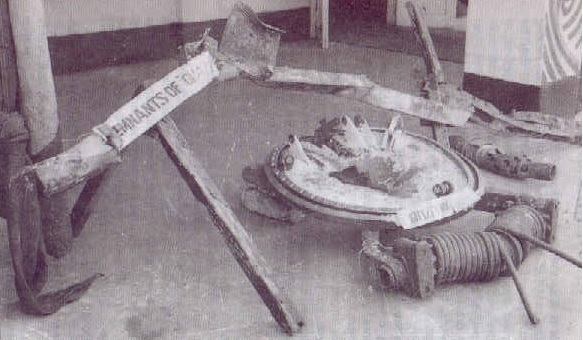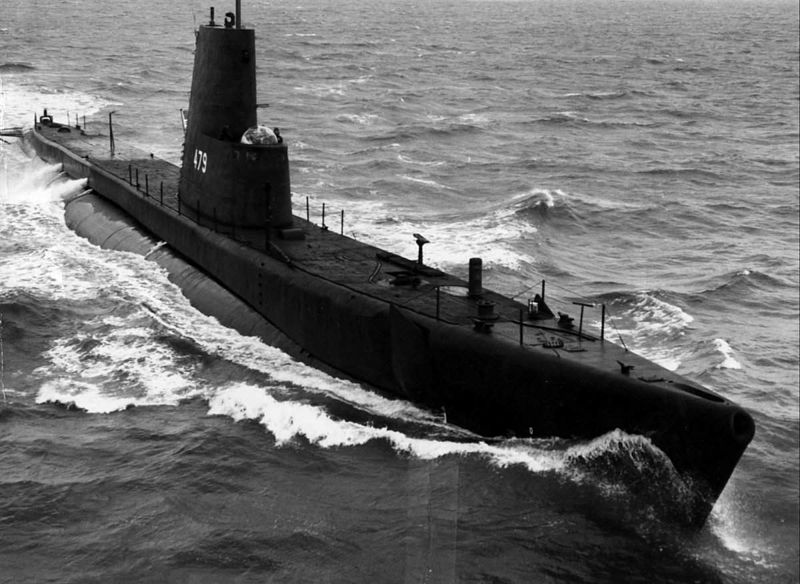The Ghazi Mystery: What Caused the Sinking of the Pakistani Submarine Near Vizag In 1971
The sinking of PNS Ghazi during the the Indo-Pak war of 1971 has long been an unsolved enigma. With the first poster of The Ghazi Attack (India’s first war-at-sea film that is based on the mysterious sinking of PNS Ghazi) being released yesterday, here's a look at theories surrounding PNS Ghazi's mysterious sinking.

The first rays of dawn had just illuminated the Vizag harbour on December 5, 1971, when Lieutenant Sridhar More steered the INS Akshay out towards the open sea. The previous day a few local fishermen had visited the Eastern Naval Command with pieces of wreckage and reported the presence of a large oil slick in the area. As a result, the fast moving patrol ship, also called a SDB (Seaward Defense Boat), had been dispatched to investigate the same.
As the INS Akshay made its way to the spot mentioned by the fishermen, Lieutenant More saw the reported oil slick immediately, stretching out as far as the eye could see. As soon as the reached the spot, a diver was quickly sent into the water to investigate. Surfacing after a few minutes, the excited diver gasped,
“Sir, it’s a submarine.”
A second diver was sent in to confirm that first one had not been mistaken. He surfaced half an hour later, bringing back more details and confirming that the source of the oil slick was indeed a sunken submarine. Lieutenant More immediately sent a message that he had located a bottomed submarine to the Maritime Operations Room (MOR) in Vizag. Soon after, the divers could make out the initials on the black shape. With the information they provided, Lieutenant More sent his second message to the operations room,
“Confirmed submarine is Pakistani.”
When the divers came back with the information that the submarine’s estimated length was over 300 feet, Lieutenant More was stunned. He knew that Pakistan had four submarines and only the largest one in the fleet was longer than 300 feet. After referring to Jane’s Fighting Ships (an annual resource book on all the warships in the world) to confirm his suspicion, he sent his last signal to the operations room at Vishakapatnam. The message, which sent ripples through the operations room, said,
“It is the Ghazi.”
The sinking of PNS Ghazi during the the Indo-Pak war of 1971 has long been an unsolved mystery. With Karan Johar sharing the first poster of his movie, The Ghazi Attack (India’s first war-at-sea film that is based on the mysterious sinking of PNS Ghazi) yesterday, the debate on what caused the blast on board the Pakistani vessel has been renewed. Let’s take a look at the many theories about this enigmatic incident that is believed to have tilted the 1971 war in India’s favour.

Photo Source
In mid-November 1971, millions of refugees were pouring into India to escape the Pakistani Army’s genocidal rampage in East Pakistan (now Bangladesh). In an effort to provide shelter to the refugees, the governments of West Bengal, Bihar, Assam, Meghalaya and Tripura had established refugee camps along the border. With the flood of impoverished East Pakistani refugees placing an intolerable strain on India’s already overburdened economy, a full scale war only seemed a matter of time.
On November 14, 1971, PNS Ghazi, crammed with food and ammunition, quietly sailed out of the Karachi Harbour into the Arabian Sea. While the submarine had been ostensibly dispatched to Chittagong in East Pakistan, its real mission was to target India’s aircraft carrier, INS Vikrant.
Formerly USS Diablo, PNS Ghazi had been built during World War II. Leased out to Pakistan, it had been renamed ‘Ghazi’ or ‘holy warrior’. South Asia’s first submarine, PNS Ghazi was Pakistan’s only submarine with a capacity to travel over 11000 nautical miles to reach Bay of Bengal and undertake operations on India’s eastern coast.

Photo Source
Intercepted transmissions had led the PNS Ghazi to believe that INS Vikrant near Vizag. As a result, the pride of Pakistani Navy was sailing to the eastern coast of India to destroy India’s flagship aircraft carrier. What the Pakistani Navy didn’t know was that this was a smart wartime ruse planned by Vice-Admiral Krishnan, the Commanding Flag Officer of the Eastern Naval Command.
Also Read: Dear Indians, Here’s How We Can Help Our Disabled Jawans Get Their Due
Signal intercepts of Pakistani Navy had indicated an imminent deployment of the Ghazi in the Bay of Bengal. So Vice-Admiral Krishnan decided to set a trap by letting Ghazi believe that INS Vikrant was in the area near Vizag. He summoned Lt. Commander Inder Singh, the captain of INS Rajput, and gave him an important mission.

Photo Source
INS Rajput, an ageing WWII destroyer had actually been recently sent to Vishakapatnam for decommissioning. As a part of the mission, the ship was to pretend to be INS Vikrant, sail out of the Vizag harbour and generate heavy wireless traffic – leading the PNS Ghazi to believe that it had received the right intel about the aircraft carrier. The wily Vice-Admiral also informed the authorities in Madras (now Chennai) that the aircraft carrier would be arriving shortly. Not leaving anything to chance, he also ordered huge quantities of food rations to indicate that the ship was in harbour near Vizag.
As he hoped, the bait was snapped up. In a signal, later recovered from the sunken Ghazi, commodore submarines in Karachi had sent a signal to the Ghazi that “intelligence indicates carrier in port. Occupy Victor Zone (a code name for Vizag) with all dispatch”. Reaching Vizag on November 27, 1971, PNS Ghazi prowled perilously close to the Indian coast, searching for its elusive quarry. Unknown to the Ghazi, INS Vikrant and her escorts had already sailed into ‘Port X-Ray’, a secret anchorage in the Andaman Island, nearly a 1000 miles away!

Photo Source
On the night of December 3-4, 1971, an explosion tore through the PNS Ghazi, blowing open its bow, crumpling the hull and cracking open the water-tight compartments. Seawater rushed in, drowning the crew as the submarine crashed to the seabed. On December 6, three days after the sinking of the PNS Ghazi, INS launched its first airstrike.
On the same day, the Indian navy’s Soviet-built submarine rescue ship INS Nistar arrived at site of Ghazi’s sinking with a specialist underwater salvage team. On exploring the sunken submarine, the team reported that the entire forward part of the submarine had been destroyed and blown outwards on the starboard side.
Four bodies had to be removed to access the submarine’s interior, and as per the worldwide naval custom, they were reburied at sea with military honors. Among the objects recovered from the interiors were a chart detailing the voyage from Karachi, the captain’s stationary pad, the ship’s log, radio messages, a Pakistani flag, and the characteristic American “flying bridge” curved windshield.

Photo Source
So, what exactly caused the blast on PNS Ghazi? This is where the debate arises. Indian Navy claims the submarine was destroyed by depth charges fired by its ship INS Rajput. Pakistani authorities say the submarine sank because of either an internal explosion or accidental blast of mines that the submarine itself was laying around Vizag harbour.
According to the Indian Navy:
At 00:14 on 4 December 1971, INS Rajput’s sonar room reported what sounded like a submarine changing depth, about half mile ahead. Captain Inder Singh ordered a sharp turn and immediately fired two depth charges from the the ship’s Mk.IV DCTs. Less than a minute later, at 00:15, a massive underwater explosion shook the destroyer. The crewmen of INS Rajput were unsure what had happened; some sailors briefly thought their destroyer had been torpedoed due to the force of the explosion. Lookouts on INS Rajput saw what was possibly an oil slick in the area. Singh felt certain he had sunk a Pakistani submarine and relayed this to Vice Admiral Krishnan at Vizag. Several minutes later, Vice Admiral Krishnan was informed that a beach patrolman in Vizag had also heard a huge explosion at 00:15.
INS Rajput then departed the area and proceed to join up with the INS Vikrant battle group. After sunrise, local fishermen saw an oil slick and some floating debris in the area. Included in the debris was an unused submariner life vest labelled “USS DIABLO”.
According to the Pakistani Navy:
PNS Ghazi commenced laying a small minefield east of the Vishakapatnam harbor mouth on the overnight of 2-3 December 1971. Then at daybreak on 3 December, it headed out to deeper water to search for the INS Vikrant battle group. Not finding it, PNS Ghazi returned to the Vishakapatnam harbor mouth area at sunset to resume laying the minefield. As the lights ashore were blacked out, PNS Ghazi may have misjudged her position and doubled back into her own minefield around midnight; about 10-15 minutes before the INS Rajput depth charging. Thus, it was the accidental detonation of its own mines that destroyed the Ghazi and not INS Rajput‘s depth charges.
Over the years, the mystery surrounding the sinking of PNS Ghazi has endured. Today, the submarine lies embedded in the Vizag seabed about 1.5 nautical miles from the breakwaters. Close to the harbour channel, the spot has been marked on navigational maps to help ships avoid the wreck.
In 2003, an attempt was made by the Eastern Naval Command to check the condition of the debris. A team of 10 drivers of the Eastern Naval Command was sent down for another look at an old enemy that had come so close and failed.

Photo Source
The images of Ghazi, taken with underwater cameras, revealed that the submarine, in death, was teeming with life. Still sitting on an even keel, the submarine’s hull, chipped away to reveal its steel skeleton, was covered with thousands of fishing nets. However, the cause of the blast still remains unclear and the decades-old-puzzle still remains unsolved. As Vice Admiral (retd) G M Hiranandani (whose book, Transition to Triumph, gives a detailed history of the Indian Navy) says,
“The truth about the Ghazi, which remains on what the submarine community calls the ‘eternal parole’, lies somewhere between the Indian and Pakistani versions of the sinking but no one knows exactly where.”
You May Like: 14 Fascinating and Perplexing Unsolved Mysteries of Indian History
Like this story? Have something to share? Email: contact@thebetterindia.
NEW! Log into www.gettbi.com to get positive news on Whatsapp.
If you found our stories insightful, informative, or even just enjoyable, we invite you to consider making a voluntary payment to support the work we do at The Better India. Your contribution helps us continue producing quality content that educates, inspires, and drives positive change.
Choose one of the payment options below for your contribution-
By paying for the stories you value, you directly contribute to sustaining our efforts focused on making a difference in the world. Together, let’s ensure that impactful stories continue to be told and shared, enriching lives and communities alike.
Thank you for your support. Here are some frequently asked questions you might find helpful to know why you are contributing?


This story made me
-
97
-
121
-
89
-
167











